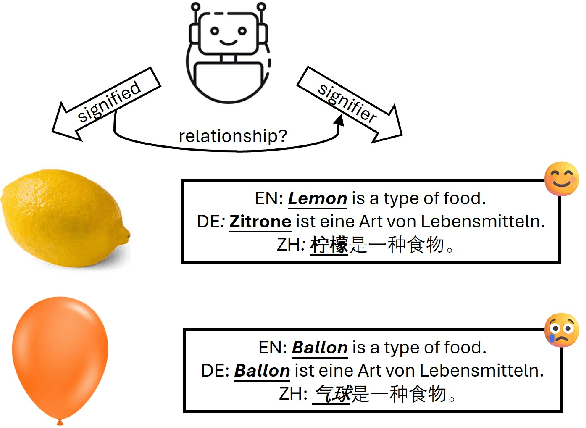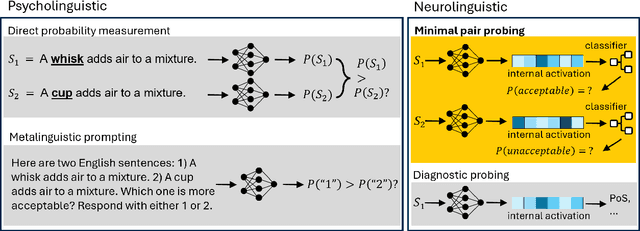Linyang He
Far from the Shallow: Brain-Predictive Reasoning Embedding through Residual Disentanglement
Oct 26, 2025Abstract:Understanding how the human brain progresses from processing simple linguistic inputs to performing high-level reasoning is a fundamental challenge in neuroscience. While modern large language models (LLMs) are increasingly used to model neural responses to language, their internal representations are highly "entangled," mixing information about lexicon, syntax, meaning, and reasoning. This entanglement biases conventional brain encoding analyses toward linguistically shallow features (e.g., lexicon and syntax), making it difficult to isolate the neural substrates of cognitively deeper processes. Here, we introduce a residual disentanglement method that computationally isolates these components. By first probing an LM to identify feature-specific layers, our method iteratively regresses out lower-level representations to produce four nearly orthogonal embeddings for lexicon, syntax, meaning, and, critically, reasoning. We used these disentangled embeddings to model intracranial (ECoG) brain recordings from neurosurgical patients listening to natural speech. We show that: 1) This isolated reasoning embedding exhibits unique predictive power, accounting for variance in neural activity not explained by other linguistic features and even extending to the recruitment of visual regions beyond classical language areas. 2) The neural signature for reasoning is temporally distinct, peaking later (~350-400ms) than signals related to lexicon, syntax, and meaning, consistent with its position atop a processing hierarchy. 3) Standard, non-disentangled LLM embeddings can be misleading, as their predictive success is primarily attributable to linguistically shallow features, masking the more subtle contributions of deeper cognitive processing.
Layer-wise Minimal Pair Probing Reveals Contextual Grammatical-Conceptual Hierarchy in Speech Representations
Sep 19, 2025Abstract:Transformer-based speech language models (SLMs) have significantly improved neural speech recognition and understanding. While existing research has examined how well SLMs encode shallow acoustic and phonetic features, the extent to which SLMs encode nuanced syntactic and conceptual features remains unclear. By drawing parallels with linguistic competence assessments for large language models, this study is the first to systematically evaluate the presence of contextual syntactic and semantic features across SLMs for self-supervised learning (S3M), automatic speech recognition (ASR), speech compression (codec), and as the encoder for auditory large language models (AudioLLMs). Through minimal pair designs and diagnostic feature analysis across 71 tasks spanning diverse linguistic levels, our layer-wise and time-resolved analysis uncovers that 1) all speech encode grammatical features more robustly than conceptual ones.
SightSound-R1: Cross-Modal Reasoning Distillation from Vision to Audio Language Models
Sep 19, 2025Abstract:While large audio-language models (LALMs) have demonstrated state-of-the-art audio understanding, their reasoning capability in complex soundscapes still falls behind large vision-language models (LVLMs). Compared to the visual domain, one bottleneck is the lack of large-scale chain-of-thought audio data to teach LALM stepwise reasoning. To circumvent this data and modality gap, we present SightSound-R1, a cross-modal distillation framework that transfers advanced reasoning from a stronger LVLM teacher to a weaker LALM student on the same audio-visual question answering (AVQA) dataset. SightSound-R1 consists of three core steps: (i) test-time scaling to generate audio-focused chains of thought (CoT) from an LVLM teacher, (ii) audio-grounded validation to filter hallucinations, and (iii) a distillation pipeline with supervised fine-tuning (SFT) followed by Group Relative Policy Optimization (GRPO) for the LALM student. Results show that SightSound-R1 improves LALM reasoning performance both in the in-domain AVQA test set as well as in unseen auditory scenes and questions, outperforming both pretrained and label-only distilled baselines. Thus, we conclude that vision reasoning can be effectively transferred to audio models and scaled with abundant audio-visual data.
XCOMPS: A Multilingual Benchmark of Conceptual Minimal Pairs
Feb 27, 2025



Abstract:We introduce XCOMPS in this work, a multilingual conceptual minimal pair dataset covering 17 languages. Using this dataset, we evaluate LLMs' multilingual conceptual understanding through metalinguistic prompting, direct probability measurement, and neurolinguistic probing. By comparing base, instruction-tuned, and knowledge-distilled models, we find that: 1) LLMs exhibit weaker conceptual understanding for low-resource languages, and accuracy varies across languages despite being tested on the same concept sets. 2) LLMs excel at distinguishing concept-property pairs that are visibly different but exhibit a marked performance drop when negative pairs share subtle semantic similarities. 3) Instruction tuning improves performance in concept understanding but does not enhance internal competence; knowledge distillation can enhance internal competence in conceptual understanding for low-resource languages with limited gains in explicit task performance. 4) More morphologically complex languages yield lower concept understanding scores and require deeper layers for conceptual reasoning.
Large Language Models as Neurolinguistic Subjects: Identifying Internal Representations for Form and Meaning
Nov 12, 2024



Abstract:This study investigates the linguistic understanding of Large Language Models (LLMs) regarding signifier (form) and signified (meaning) by distinguishing two LLM evaluation paradigms: psycholinguistic and neurolinguistic. Traditional psycholinguistic evaluations often reflect statistical biases that may misrepresent LLMs' true linguistic capabilities. We introduce a neurolinguistic approach, utilizing a novel method that combines minimal pair and diagnostic probing to analyze activation patterns across model layers. This method allows for a detailed examination of how LLMs represent form and meaning, and whether these representations are consistent across languages. Our contributions are three-fold: (1) We compare neurolinguistic and psycholinguistic methods, revealing distinct patterns in LLM assessment; (2) We demonstrate that LLMs exhibit higher competence in form compared to meaning, with the latter largely correlated to the former; (3) We present new conceptual minimal pair datasets for Chinese (COMPS-ZH) and German (COMPS-DE), complementing existing English datasets.
Remote Sensing-Based Assessment of Economic Development
Nov 07, 2024



Abstract:The goal of our project is to use satellite data (including nighttime light data and remote sensing images) to give us some statistical estimation of the economic development level of a selected area (Singapore). Findings from the project could inform policymakers about areas needing intervention or support for economic development initiatives. Insights gained might aid in targeted policy formulation for infrastructure, agriculture, urban planning, or resource management.
Decoding Probing: Revealing Internal Linguistic Structures in Neural Language Models using Minimal Pairs
Mar 26, 2024Abstract:Inspired by cognitive neuroscience studies, we introduce a novel `decoding probing' method that uses minimal pairs benchmark (BLiMP) to probe internal linguistic characteristics in neural language models layer by layer. By treating the language model as the `brain' and its representations as `neural activations', we decode grammaticality labels of minimal pairs from the intermediate layers' representations. This approach reveals: 1) Self-supervised language models capture abstract linguistic structures in intermediate layers that GloVe and RNN language models cannot learn. 2) Information about syntactic grammaticality is robustly captured through the first third layers of GPT-2 and also distributed in later layers. As sentence complexity increases, more layers are required for learning grammatical capabilities. 3) Morphological and semantics/syntax interface-related features are harder to capture than syntax. 4) For Transformer-based models, both embeddings and attentions capture grammatical features but show distinct patterns. Different attention heads exhibit similar tendencies toward various linguistic phenomena, but with varied contributions.
Survey on deep learning in multimodal medical imaging for cancer detection
Dec 04, 2023Abstract:The task of multimodal cancer detection is to determine the locations and categories of lesions by using different imaging techniques, which is one of the key research methods for cancer diagnosis. Recently, deep learning-based object detection has made significant developments due to its strength in semantic feature extraction and nonlinear function fitting. However, multimodal cancer detection remains challenging due to morphological differences in lesions, interpatient variability, difficulty in annotation, and imaging artifacts. In this survey, we mainly investigate over 150 papers in recent years with respect to multimodal cancer detection using deep learning, with a focus on datasets and solutions to various challenges such as data annotation, variance between classes, small-scale lesions, and occlusion. We also provide an overview of the advantages and drawbacks of each approach. Finally, we discuss the current scope of work and provide directions for the future development of multimodal cancer detection.
Do self-supervised speech and language models extract similar representations as human brain?
Oct 07, 2023



Abstract:Speech and language models trained through self-supervised learning (SSL) demonstrate strong alignment with brain activity during speech and language perception. However, given their distinct training modalities, it remains unclear whether they correlate with the same neural aspects. We directly address this question by evaluating the brain prediction performance of two representative SSL models, Wav2Vec2.0 and GPT-2, designed for speech and language tasks. Our findings reveal that both models accurately predict speech responses in the auditory cortex, with a significant correlation between their brain predictions. Notably, shared speech contextual information between Wav2Vec2.0 and GPT-2 accounts for the majority of explained variance in brain activity, surpassing static semantic and lower-level acoustic-phonetic information. These results underscore the convergence of speech contextual representations in SSL models and their alignment with the neural network underlying speech perception, offering valuable insights into both SSL models and the neural basis of speech and language processing.
 Add to Chrome
Add to Chrome Add to Firefox
Add to Firefox Add to Edge
Add to Edge